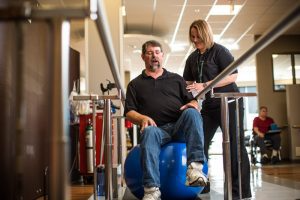Many times we get the common question from physicians, adjusters and NCM’s, “What do you mean there is a difference between work conditioning and work hardening?” The truth is, there is a big difference, especially for your injured worker.

These programs are ideal for patients that have already progressed through traditional physical therapy but still lack full function in relation to specific duties required on the job.
Work conditioning and work hardening utilize real or simulated work tasks to help prepare patients for a safe transition back into the workforce while preventing new or worsened injuries.
So what IS the difference?
Work Conditioning
Work conditioning is a rigorous conditioning program designed to help patients regain their systemic, and musculoskeletal functions. This includes strength, mobility, power, endurance, motor control and functional abilities.
Work conditioning provides a middle step in the process of returning to work. The goals of a work conditioning program are to restore the patient’s physical capacity and functional abilities, to prevent the recurrence of the same injury, and to decrease their fear of returning to work.
A typical work conditioning program is 2-4 hours a day, 3-5 days per week. The objective is to have the injured worker simulating typical work tasks for up to 50% of their normal work schedule.
Watch the video below that show’s our S.P.O.R.T Program:
Work Hardening
Work hardening is an individualized, highly-structured program designed to help patients return to their pre-injury work level in a safe and timely manner. It aims to help patients regain their biomechanical, cardiovascular, metabolic, neuromuscular and psychosocial functions in conjunction with their work tasks.
Work hardening is multidisciplinary, using a physical therapist, occupational therapist, psychologist and vocational specialist. It includes strengthening and flexibility exercises, cardiovascular conditioning, spine and joint stabilization exercises and job task training (i.e. pushing, pulling, crouching, lifting, bending, sitting, or twisting).
See the difference? Both programs can benefit, but the bottom line is you have to choose between focusing on restoring the patient’s physical capacity and functional abilities OR focusing on physical capacity, functional abilities, speech and neurological abilities.

Who can benefit from Work Conditioning/Hardening
- Police Officers
- Firefighters
- Electricians
- Plumbers
- FBI Agents
- Correction Officers
- Mechanics
- Construction Workers
- Healthcare Providers
- Painters
- Delivery Drivers
- Post office employees
- Chefs
- Any other labor-intensive professionals
What to expect at a Work Conditioning/Work Hardening Evaluation
Work conditioning and work hardening are four to eight week functional programs designed to meet the specific job needs of the patient. Each program is individualized to treat the patient’s specific injury and dependent on what the treating physician prescribes.
The time and length of the sessions can usually be tailored around the patients work schedule and we can work with the employer to make sure we are following the patient’s job description.

Functional Baseline
At the first visit, a therapist will evaluate the injury and review the patients’ needs in relation to their job. To determine the patient’s functional baseline, the therapist will need to:
- Determine the patient’s current physical activeness (sedentary, light, medium or heavy).
- Determine the patient’s aerobic capacity (poor, fair, average, good or excellent).
- Determine the patient’s grip strength.
- Determine the patient’s mobility, core and joint specific strengths in relation to their injury.
After the functional baseline is determined, an individualized program will be designed to increase the patient’s current physical abilities. This will be done with medium to high intensity cardiovascular and strengthening exercises as well as stretching and mobility conditioning specifically tailored to the tasks the patient is required to perform at their job.
The referring physician, and any other authorized parties, will be given periodic progress updates which will document the patient’s attendance, participation, and progression. Discharge orders are given when the patient either regains full function or they reach a plateau in care.
Have someone that would benefit from our services?
Here at Robbins Rehabilitation West, our Workforce Toolkit Program, gives employees the tools to return back to work, while giving employers the tools to minimize their overall cost.
We offer work conditioning at all of our facilities. To make an appointment for your injured worker please call 610-839-8764 or if you are interested in learning more about our overall Worker’s Compensation program Click Here and click on “Sign Up for a Free Lunch and Learn” to schedule an appointment with our Director of Workers’ Compensation.


